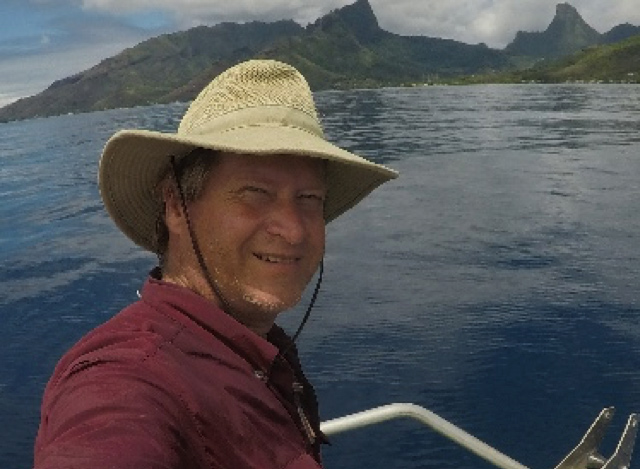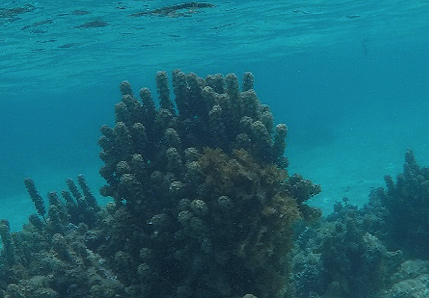Matthew P. Hoch

Associate Professor of Biology
Office: 241 Science & Technology Building
Phone: 409-880-8264
Email: matt.hoch@lamar.edu
Education:
1991 Ph.D. in Marine Biology and Biochemistry, University of Delaware
1985 B.A. in Environmental Population and Organismal Biology, University of Colorado
1992-1996 postdoctoral research, Department of Oceanography, Texas A&M University at the U.S. EPA, Gulf Coast Ecology Research Laboratory, Gulf Breeze, Florida
Recent Courses Taught:
Tropical Marine Biology (BIOL 4401/5401) and Tropical Watershed Ecology (BIOL 4401/5401)
Environmental Microbiology (BIOL 4437/5437)
Microbiology (BIOL 2420)
General Biology (BIOL 1308; BIOL 1406)
Environmental Toxicology (BIOL 4435/5435)
Biological Oceanography (BIOL 4401/5401)
Research Interests:
The ecology of aquatic microbial communities; specifically sulfate reducing prokaryotes in salt marsh sediments, bacterioplankton in Lake Sabine Estuary, and finfish microbiomes. Watershed ecology, with focus on assessment of water quality, periphyton, macroinvertebrates, and fish in stream ecosystems. Nitrogen cycling and the role of nitrogen limitation on bacterioplankton and periphyton communities.
Current projects in need of student assistance:
-
Understanding changes in diversity of sulfate reducing bacteria (SRbs) in coastal marsh sediments in response to relative sea level rise and seawater intrusion, subsequent marsh decline, and sediment-subsidy restoration.
-
Defining microbiomes (communities of resident microbes) on mucosal membrane surfaces of Mugil cephalus (striped mullet) as a first step to understand the microbial role in fish health under different environmental conditions.
-
Studying physicochemical controls of bacterioplankton and phytoplankton communities in the Sabine Lake Estuary, a shallow well-mixed turbid estuary dominated by freshwater inflows, and the role of benthic coupling.
-
Assessing stream continuum concepts in tropical watersheds of the Maya Mountains in Belize Central America as part of the Tropical Biology Program. Additional work on the nutrient controls of periphyton communities in streams of Belizean watersheds with granitic versus limestone geology is planned.
Undergraduates interested in participating in these research programs please contact Dr. Hoch for further information.
Selected Peer-Reviewed Publications:
Hoch, M.P., C.Y.S. Siu, S.E. Clark, and K.H. Baker. 2009. Codorus Creek Restoration - A Case Study for the Chesapeake Bay. Proceedings of the World Environmental and Water Resources Congress 2009: Great Rivers, American Society of Civil Engineers. pp 1-7.
Hoch, M.P. 2008. Enzymatic assessment of nitrogen and phosphorus bioavailability to stream periphyton communities at different velocity regimes. J. Freshwater Ecol. 23(2): 245-264.
Hoch, M. P., K. S. Dillon, R. B. Coffin, and L. A. Cifuentes. 2008. Sensitivity of bacterioplankton nitrogen metabolism to eutrophication in sub-tropical coastal waters of Key West, Florida. Mar. Poll. Bull. 56(5): 913-926.
Hoch, M.P. and D. A. Bronk. 2007. Bacterioplankton nutrient metabolism in the Eastern Tropical North Pacific. J Exp. Mar. Biol. Ecol. 439: 390-404.
Eaton, W.D., V. Palacio, E. vanZinderenBakker, and M.P. Hoch. 1999. Nutrient and microbial analysis of watersheds above and below the Mollejon Dam, Belize. Mesoamerican Society for Conservation and Biology, Mesoamericana. 4(4): 20-24.
Hoch, M.P., R.A. Snyder, L.A. Cifuentes, and R.B. Coffin. 1996. Stable isotope dynamics of nitrogen recycled during interactions among marine bacteria and protists. Mar. Ecol. Prog. Ser. 132: 229-239.
Hoch, M.P. and D.L. Kirchman. 1995. Ammonium uptake by bacteria in the Delaware Estuary and coastal water. Limnol. Oceanogr. 40: 886-897.
Hoch, M.P., M.L. Fogel, and D.L. Kirchman. 1992. Isotope fractionation associated with ammonium uptake by a marine bacterium. Limnol. and Oceanogr. 37(7): 1447-1459.
Bio:
Matthew P. Hoch has loved living and recreating on lakes, streams, bays, and oceans throughout his childhood to today. He was an undergraduate student researcher through the Institute of Arctic and Alpine Research, University of Colorado, and studied aquatic macroinvertebrate communities of streams and lakes formed by the Arikaree Glacier in the Rocky Mountains. He earned his Ph.D. in Marine Biology and Biochemistry from the College of Earth, Ocean, and Environment, University of Delaware, the role of bacteria in estuary nitrogen cycling. His expertise in microbial oceanography extended to studies of the Mississippi River Plume, Eastern Tropical North Pacific, and the Florida Keys while working with the U.S. EPA Gulf Ecology Research Lab and TAMU, Oceanography. He has held academic positions at primarily undergraduate teaching universities for the past 22 years. When at Vancouver Island University, British Columbia, Canada, he became involved in a research and training study with University of Belize on the microbial water quality of Belize River Watershed, and he began developing and providing study abroad curriculum on tropical watershed and marine ecology. At Penn State University he worked on watershed restoration research, while teaching oceanography, environmental science, microbiology, ecology courses on campus and his tropical watershed and marine ecology courses in Belize, Central America.
As a faculty at Lamar University since fall 2008, he has continued teaching students tropical watershed and marine ecology in Belize, with his teaching collaborator, Dr. Ana Christensen. In fact the next iteration of the two-course (8 credit) LU Tropical Biology Program for Biology and Environmental Science B.S. majors is scheduled for summer 2019. His research at LU, which has involved 51 students, has expanded into studies of marsh sediment microbiology and biogeochemical processes related to marsh loss and restoration on the Southeast Texas coast, estuary microbial oceanography of Sabine Lake and Salt Bayou Estuary (aka Keith-Johnson-Shell Lakes), watersheds in Belize, and coral reef molecular microbiology. The latter research program focuses on how microbes respond to conditions caused directly or indirectly by human activities that lead to their role in coral morbidity and mortality. Current coral reef microbiology project topics include: 1) The impact of sea surface temperature rise due to climate change on the microbiome of corals; 2) Increased microbialization of the Meso-American Barrier Reef in Belize; 3) T he positive feedback interactions between macroalgal growth, the dissolved organic matter (DOM) they release, subsequent bacterial pathogen growth, and then coral loss to disease on coral reefs in Belize and Mo’orea, French Polynesia; and 4) An upcoming project in Belize on the role of plastic pollution discharged in river runoff after heavy rains and transported to the reef where it can increase the incidence of coral disease. His recent coral reef microbiology research has been funded by LU and a National Science Foundation grant.